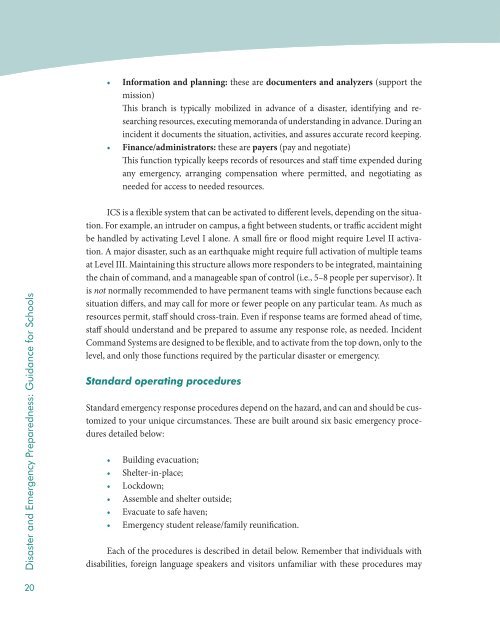Disaster and Emergency Preparedness: Guidance for ... - INEE Toolkit
Disaster and Emergency Preparedness: Guidance for ... - INEE Toolkit
Disaster and Emergency Preparedness: Guidance for ... - INEE Toolkit
Create successful ePaper yourself
Turn your PDF publications into a flip-book with our unique Google optimized e-Paper software.
In<strong>for</strong>mation <strong>and</strong> planning: these are documenters <strong>and</strong> analyzers (support themission)This branch is typically mobilized in advance of a disaster, identifying <strong>and</strong> researchingresources, executing memor<strong>and</strong>a of underst<strong>and</strong>ing in advance. During anincident it documents the situation, activities, <strong>and</strong> assures accurate record keeping.Finance/administrators: these are payers (pay <strong>and</strong> negotiate)This function typically keeps records of resources <strong>and</strong> staff time expended duringany emergency, arranging compensation where permitted, <strong>and</strong> negotiating asneeded <strong>for</strong> access to needed resources.<strong>Disaster</strong> <strong>and</strong> <strong>Emergency</strong> <strong>Preparedness</strong>: <strong>Guidance</strong> <strong>for</strong> SchoolsICS is a flexible system that can be activated to different levels, depending on the situation.For example, an intruder on campus, a fight between students, or traffic accident mightbe h<strong>and</strong>led by activating Level I alone. A small fire or flood might require Level II activation.A major disaster, such as an earthquake might require full activation of multiple teamsat Level III. Maintaining this structure allows more responders to be integrated, maintainingthe chain of comm<strong>and</strong>, <strong>and</strong> a manageable span of control (i.e., 5–8 people per supervisor). Itis not normally recommended to have permanent teams with single functions because eachsituation differs, <strong>and</strong> may call <strong>for</strong> more or fewer people on any particular team. As much asresources permit, staff should cross-train. Even if response teams are <strong>for</strong>med ahead of time,staff should underst<strong>and</strong> <strong>and</strong> be prepared to assume any response role, as needed. IncidentComm<strong>and</strong> Systems are designed to be flexible, <strong>and</strong> to activate from the top down, only to thelevel, <strong>and</strong> only those functions required by the particular disaster or emergency.St<strong>and</strong>ard operating proceduresSt<strong>and</strong>ard emergency response procedures depend on the hazard, <strong>and</strong> can <strong>and</strong> should be customizedto your unique circumstances. These are built around six basic emergency proceduresdetailed below:Building evacuation;Shelter-in-place;Lockdown;Assemble <strong>and</strong> shelter outside;Evacuate to safe haven;<strong>Emergency</strong> student release/family reunification.Each of the procedures is described in detail below. Remember that individuals withdisabilities, <strong>for</strong>eign language speakers <strong>and</strong> visitors unfamiliar with these procedures may20
















